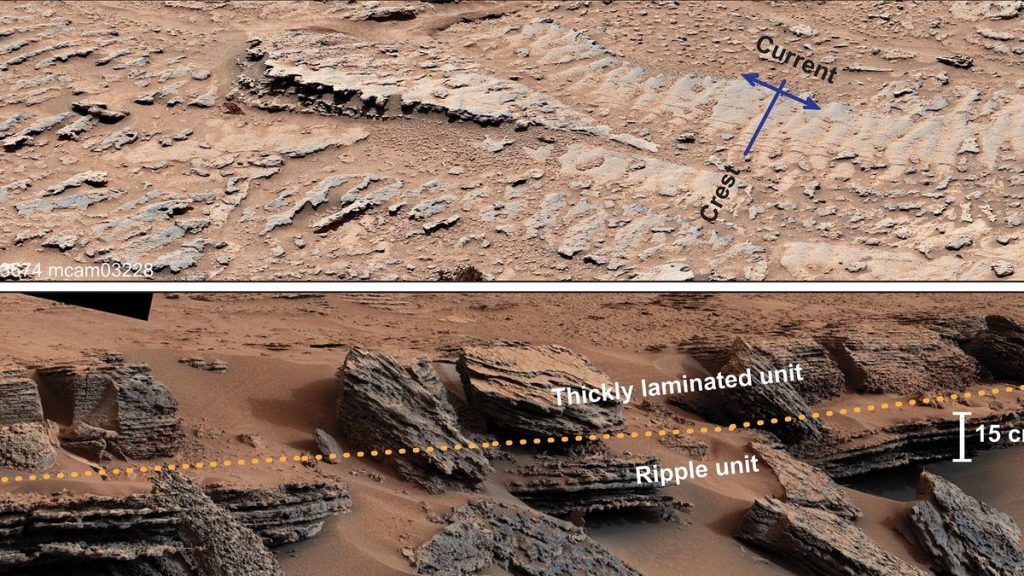NASA rover discovers liquid water ‘ripples’ carved into Mars rock — and it could rewrite the Red Planet’s history – Livescience.com

NASA’s Curiosity rover photographed remnants of rippling waves in an ancient Martian lakebed, proving that the Red Planet had open water for longer in its history than previously thought.
When you purchase through links on our site, we may earn an affiliate commission. Here’s how it works.
Scientists have discovered evidence that liquid water was once exposed to the air in ancient, shallow lakes on Mars. The finding is evidence that not all water on the Red Planet was covered in ice, as some Martian climate models suggest.Planetary geologists and astronomers studying Mars have known for decades that water was once likely present on the planet, after NASA’s Mariner 9 mission captured images of dry gullies in the 1970s. But there has been ongoing debate about what form that water took and how long it lasted. Some models predict that any liquid water on Mars’ surface must have been covered by sheets of ice before it disappeared.However, the new findings, which were published Jan. 15 in the journal Science Advances,, tell a different story. The patterns, which were photographed by NASA’s Curiosity rover, are known as wave ripples — minute ridge-like structures that form along the shores of lakebeds. This means that exposed liquid water must have flowed across Mars’ surface at some point in its history. The ripples were present in two separate lakebeds in Gale Crater, which Curiosity has been exploring since Aug. 2012.”The shape of the ripples could only have been formed under water that was open to the atmosphere and acted upon by wind,” study first author Claire Mondro, a sedimentologist at CalTech, said in a statement.Related: 32 things on Mars that look like they shouldn’t be thereThe researchers also analyzed the height and spacing of the ripple waves to determine the size of the lake that formed them. The structures are approximately 0.2 inches (6 millimeters) tall and about 1.6 to 2 inches (4 to 5 centimeters) apart, indicating they were left by small waves. Based on these dimensions, the researchers believe the Martian lake must have been less than 2 meters (6.5 feet) deep.—New NASA images reveal giant hole in Curiosity rover’s wheel after 12 years of ‘abuse’ on Mars—Giant ‘kidney beans’ spotted in Mars satellite images could point to signs of water and life—Space photo of the week: Dry ice ‘geysers’ erupt on Mars as spring hits the Red PlanetBoth dry lakebeds appear to have formed around 3.7 billion years ago, indicating that Mars had an atmosphere dense and warm enough to support liquid water for longer than previously thought — which could have intriguing implications. “Extending the length of time that liquid water was present extends the possibilities for microbial habitability later into Mars’s history,” Mondro said. In other words: living organisms may have had a longer window in which they could have evolved on the Red Planet.Get the world’s most fascinating discoveries delivered straight to your inbox.Most of Mars’ atmosphere and surface water were later stripped away over billions of years. Scientists believe this occurred because the planet lost its magnetic field, leaving it vulnerable to solar radiation. As the powerful solar wind bombarded the Martian atmosphere, most of the planet’s carbon dioxide and water evaporated into space, leaving behind the frigid desert we know today.Joanna Thompson is a science journalist and runner based in New York. She holds a B.S. in Zoology and a B.A. in Creative Writing from North Carolina State University, as well as a Master’s in Science Journalism from NYU’s Science, Health and Environmental Reporting Program. Find more of her work in Scientific American, The Daily Beast, Atlas Obscura or Audubon Magazine.Please logout and then login again, you will then be prompted to enter your display name.Space photo of the week: Dry ice ‘geysers’ erupt on Mars as spring hits the Red PlanetMars quiz: Is your knowledge of the Red Planet out of this world?Ancient Egyptian ‘granary with scribes’ diorama: A miniature workplace found buried in a tomb from the Middle Kingdom
Live Science is part of Future US Inc, an international media group and leading digital publisher. Visit our corporate site.
©
Future US, Inc. Full 7th Floor, 130 West 42nd Street,
New York,
NY 10036.






